A freeze dryer takes water out of food and other things. It does this by using cold temperatures and a vacuum. You can use a freeze dryer to keep food fresh for many years. The food does not lose much flavor or nutrition. Many businesses, like medicine and food companies, now use freeze drying. The freeze dryer market has grown fast. In 2024, it reached over a billion dollars. More people and companies are seeing how useful it is.
Key Takeaways
A freeze dryer takes out almost all water from food. It uses cold and a vacuum to do this. This keeps the taste, nutrients, and texture safe for up to 25 years.
Freeze drying starts by freezing the food. Then it makes a vacuum. The ice turns straight into vapor. This is called sublimation. It helps food stay fresh and light.
Freeze dryers keep more vitamins and minerals than dehydrators. They also keep the food’s shape. Freeze dryers make food last much longer. But they cost more and use more energy.
Home freeze dryers help you save fruits, vegetables, and meats. You can even save whole meals. They are good for emergencies, camping, or daily use. They are easy to use.
Freeze drying has many good points. It lets you store food for a long time. It keeps nutrients and works for many foods. But it takes time and needs careful cleaning. It also costs more at first.
What Are the Basics of Freeze Drying?
Freeze drying, or lyophilization, is a dehydration process used to preserve perishable materials by freezing them, lowering the pressure, and then removing the ice by sublimation.
What Is a Freeze Dryer
A freeze dryer is a machine that takes out almost all the water from food or other things. People use it to keep food fresh for a long time. The freeze dryer makes food very cold and then removes the water as a gas. This is called freeze drying. You can find freeze dryers in homes, labs, and big factories. Many people use them to store food, and scientists use them for medicine and research.
You might wonder how a freeze dryer is not the same as a dehydrator. Here is a table that shows the main differences:
Feature | Freeze Dryer | Dehydrator |
|---|---|---|
Working Principle | Freezes food and removes moisture by sublimation under vacuum at sub-zero temperatures, preserving nutrients, flavor, and appearance. | Uses heat and air circulation to evaporate moisture at higher temperatures, causing shrinkage and nutrient loss. |
Nutrient Retention | Retains about 90-97% of nutrients including vitamins and minerals; enzymes remain intact due to low temperature. | Some nutrient loss, especially heat-sensitive vitamins; enzymes are mostly destroyed by heat. |
Shelf Life | Up to 25 years with proper packaging; inhibits bacterial and mold growth due to very low moisture. | Typically 1 to 5 years; retains some moisture, allowing potential bacterial/mold growth. |
Cost | High initial cost ($2,500 to $50,000+), power-intensive, requires maintenance like vacuum pump oiling. | Much cheaper ($40 to $3,000), low power consumption, easy to maintain. |
Final Food Quality | Maintains original shape, texture, and taste; rehydrates well. | Food shrinks, becomes chewy or crispy; taste is concentrated and different from fresh food. |
Use Cases | Long-term storage, emergency preparedness, pharmaceutical applications, high-moisture foods. | Everyday use, snack preparation, budget-conscious users, short-term preservation. |
A freeze dryer keeps food looking and tasting almost like fresh food. Freeze drying also saves most of the vitamins and minerals. Dehydrators use heat, which can destroy some nutrients and change how food feels.
There are different types of freeze dryers. Home models come in small, medium, and large sizes. Some can dry up to 50 pounds of food at once. Big freeze dryers are used in factories and labs. You can pick different pumps, like oil or oil-free, depending on how much work you want to do.
How Freeze Dryers Work
You use a freeze dryer to start freeze drying. First, you put your food or other things inside the machine. The freeze dryer makes everything very cold, so the water turns to ice. Next, the machine makes a strong vacuum. This vacuum lets the ice turn straight into vapor, skipping the liquid step. Scientists call this “sublimation.”
Tip: Sublimation is what makes freeze drying work. It helps food keep its shape, color, and nutrients.
The freeze dryer has four main parts:
A drying chamber holds the food and keeps it cold.
A vacuum pump takes out the air and lowers the pressure.
A heat source adds a little warmth to help the ice turn into vapor.
A condenser catches the vapor and turns it back into ice, keeping it away from the food.
These parts work together to take out almost all the water. Freeze drying removes about 98-99% of the moisture. This makes food very light and stops bacteria or mold from growing. You can keep freeze dried food for up to 25 years if you pack it right.
Here is a quick look at how freeze drying compares to other ways of drying food:
Drying Technology | Power Usage (Watts) | Preservation Quality & Shelf Life | |
|---|---|---|---|
Freeze Drying | 5-10 | 750-2000+ (home to industrial) | Superior nutrient retention, texture, shelf life up to 25 years |
Canning | 1-2 | N/A | Shelf life up to 2 years, uses high heat |
Dehydrating | 1-2 | N/A | Lower cost, faster, but less nutrient retention |
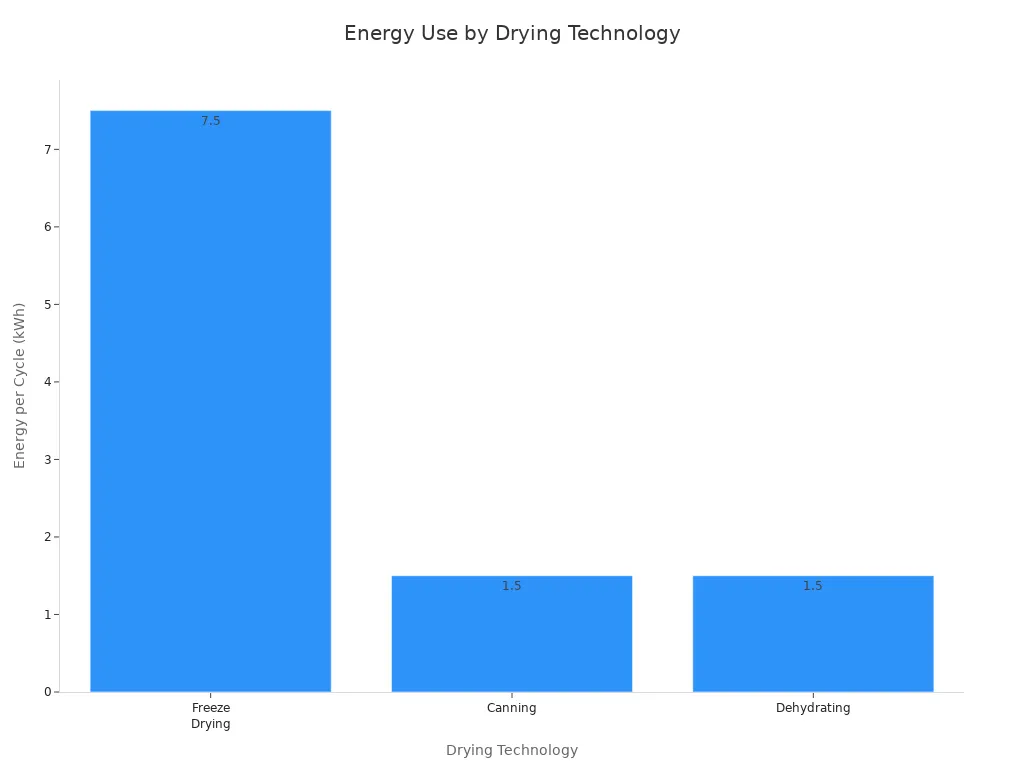
Freeze drying uses more energy than canning or dehydrating. It takes longer and needs special machines. But you get better food quality and a much longer shelf life.
Freeze drying takes out almost all the water, so food weighs less. This makes it good for camping or emergency kits.
Freeze drying keeps most vitamins and minerals, except for some vitamin C.
Freeze dried food keeps its shape and texture, but dehydrated food looks shriveled.
A freeze dryer is a great tool if you want to keep food fresh for years. Freeze drying uses science to protect taste, nutrition, and how food looks. You can pick a freeze dryer that fits your needs, whether you want to store food at home or for a business.
What Is the Freeze Drying Process?
Freeze drying, or lyophilization, is a dehydration process used to preserve perishable materials by freezing them and then reducing the surrounding pressure to allow the frozen water to sublimate directly from solid to gas.
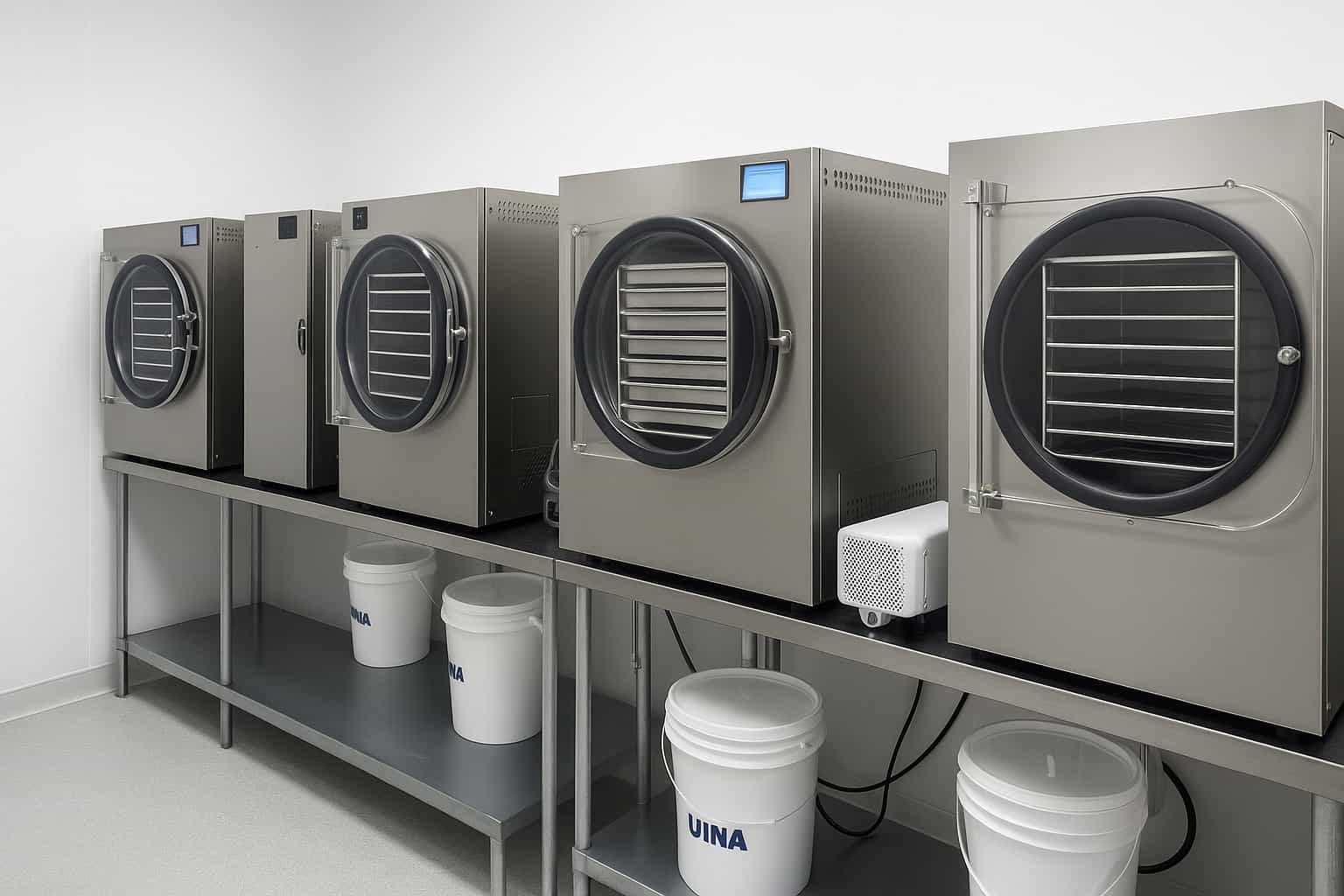
Freezing Stage
You begin freeze drying by freezing your food or material. This step is very important for the whole process. You need to freeze things quickly and at the right temperature. Fast freezing makes small ice crystals. These small crystals help keep the food’s texture and shape. Slow freezing makes big ice crystals. Big crystals can hurt the food’s structure.
Here is a table that shows the best freezing temperatures for different materials:
Material Type | Freezing Temperature Range (°C) |
|---|---|
Fruits | -40 to -30 |
Vegetables | -40 to -30 |
Meat | -30 to -20 |
Dairy Products | -40 to -30 |
Freezing food at these temperatures stops big ice crystals from forming. This helps keep the food’s flavor, color, and nutrients. How fast you freeze also changes the final quality. Quick freezing makes small crystals. Small crystals make drying easier and help food rehydrate better later.
Aspect | Effect of Freezing Rate | Impact on Freeze-Dried Product Quality |
|---|---|---|
Ice Crystal Size | Fast freezing → small crystals; Slow freezing → large crystals | Decides pore size and microstructure after sublimation |
Microstructure | Controlled by freezing rate | Changes moisture, ascorbic acid, water solubility, wettability, and color |
Mass Transfer During Drying | Pore size affects mass flow | Changes drying speed and how well food comes back to life |
Reconstitution Properties | Pore structure affects wetting and solubility | Decides how easy it is to rehydrate and the final product quality |
The freezing stage shapes the whole freeze drying process. If you freeze food the right way, you get better results at the end.
Vacuum and Sublimation
After freezing, you move to the next step. You put the frozen food in a vacuum chamber. The machine takes out most of the air. This makes a low-pressure space. This is where the science of freeze drying really works.
In this step, the ice inside your food does not melt. It changes straight from a solid to a gas. Scientists call this “sublimation.” Sublimation only happens with the right pressure and cold temperature. The vacuum pressure must match the vapor pressure of the frozen food. Usually, you set the vacuum at about half the vapor pressure for the best results.
Note: If you set the vacuum too low, the process slows down or can hurt the food. You must control the vacuum carefully, especially for things like proteins.
Here are some key points about pressure control during sublimation:
Sublimation needs exact pressure to work.
The vacuum must match the vapor pressure of the frozen sample.
Too much vacuum can cause problems, so you need good control.
Programmable vacuum systems help keep the process gentle and safe for your food.
Freeze drying uses this science to keep food safe and tasty. Sublimation removes water without heat. This helps food keep its shape, color, and most nutrients. That is why freeze drying is great for saving food and other things.
Secondary Drying
You finish freeze drying with secondary drying. Even after sublimation, some water stays in the food. This water sticks to the food at a tiny level. You need to remove this last bit to make your food last a long time.
During secondary drying, you slowly raise the temperature. This step removes water that did not leave during sublimation. At first, the moisture drops quickly. For example, at 0°C, the moisture can fall from about 7% to 4% in just two hours. After eight hours, it can reach around 2%. If you use a lower temperature, like -10°C, the moisture drops more slowly but still goes below 4%. Most freeze drying aims for less than 1% moisture at the end. Some products, like certain medicines, may keep a bit more moisture for stability.
Secondary drying is very important for shelf life. Here is why:
This stage removes water that could cause spoilage.
Lower moisture raises the glass transition temperature, which helps the food keep its shape.
Less water means less chance for unwanted changes during storage.
The right temperature and pressure keep the food’s structure safe.
If you use too much heat, you can damage the food, so you must balance speed and safety.
Good control during secondary drying gives you a stable, high-quality product that lasts for years.
Freeze drying is more than just freezing and drying. Each stage in the freeze drying process is important. When you follow each step carefully, you get food that looks, tastes, and feels almost like fresh. You also get a product that can last for decades on your shelf.
Which Parts Make Up a Freeze Dryer System?
A freeze dryer system consists of several critical components that work together to remove moisture from materials through sublimation. The main parts include the vacuum chamber, refrigeration system, vacuum pump, and control system.
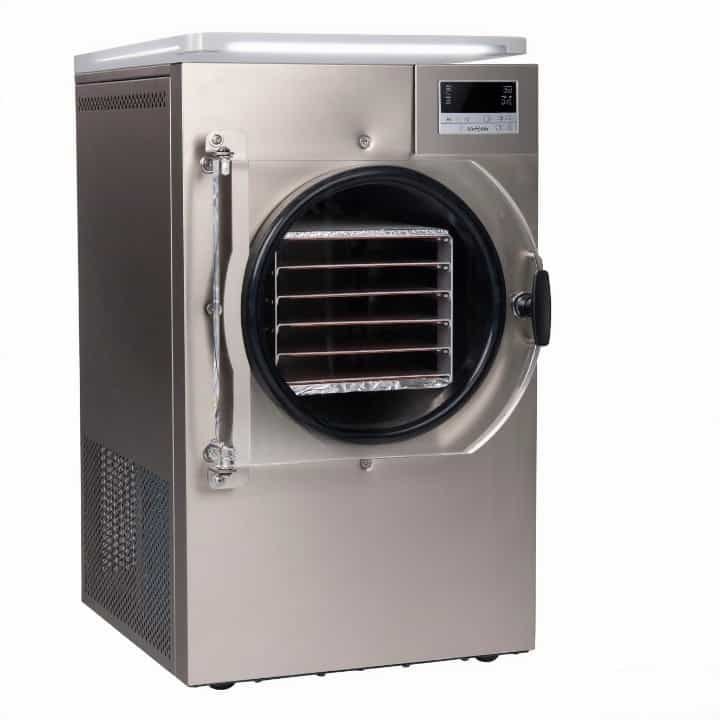
Freezing Chamber
The freezing chamber is where you put your food before freeze drying. This chamber does more than just hold things. It keeps everything very cold and seals out air. This is important for freeze drying to work. The shelves inside can freeze food and also warm it up a little. This helps water turn into vapor during sublimation. The chamber works with the vacuum pump and condenser to get rid of water vapor and other gases. These features help your food keep its shape and stay good.
Here are some main jobs of the freezing chamber:
Holds your frozen food during the whole process
Keeps the chamber sealed tight from air
Controls shelf temperature for freezing and warming
Removes extra gases with the vacuum pump
Works with other parts to keep food quality
You will often see these materials and features in a freezing chamber:
Material/Feature | Purpose/Benefit |
|---|---|
Stops rust and lasts a long time | |
High-efficiency insulation | Keeps cold in and saves energy |
Programmable controls | Lets you set exact temperatures |
Low-temperature compressor | Runs steady and saves power |
Vacuum Pump
The vacuum pump makes the low pressure needed for freeze drying. You need a strong vacuum to help ice turn into vapor. Many freeze dryers use rotary vane or liquid ring pumps. These pumps need a lot of care and can leak oil. New dry vacuum pumps, like dry screw pumps, do not use oil. They are cleaner, easier to take care of, and use less energy. Dry pumps also stop oil problems and help your freeze dryer work better. For food freeze dryers, the vacuum pump usually gets to about 10 Pa. This is low enough for good drying.
Condenser
The condenser is an important part of your freeze dryer. It catches water vapor that leaves your frozen food. The condenser has very cold coils or plates, often colder than -50°C. When water vapor hits these cold parts, it freezes and sticks as frost. This keeps vapor from going back into the chamber. It helps keep the vacuum and makes drying work better. By trapping water, the condenser helps your food keep its shape and nutrients.
Here is a table showing usual condenser temperatures for different freeze dryer systems:
Refrigeration System Type | Shelf Temperature Range (°C) | Condenser Temperature (°C) | Suitable Product Type |
|---|---|---|---|
Single-stage refrigeration | -35 to -40 | -50 | Easy-to-freeze-dry products (like food, meat) |
Two-stage refrigeration | -45 to -50 | -65 | Most medicine products |
Cascade refrigeration | -55 to -60 | -75 | Special products needing very low temperatures |
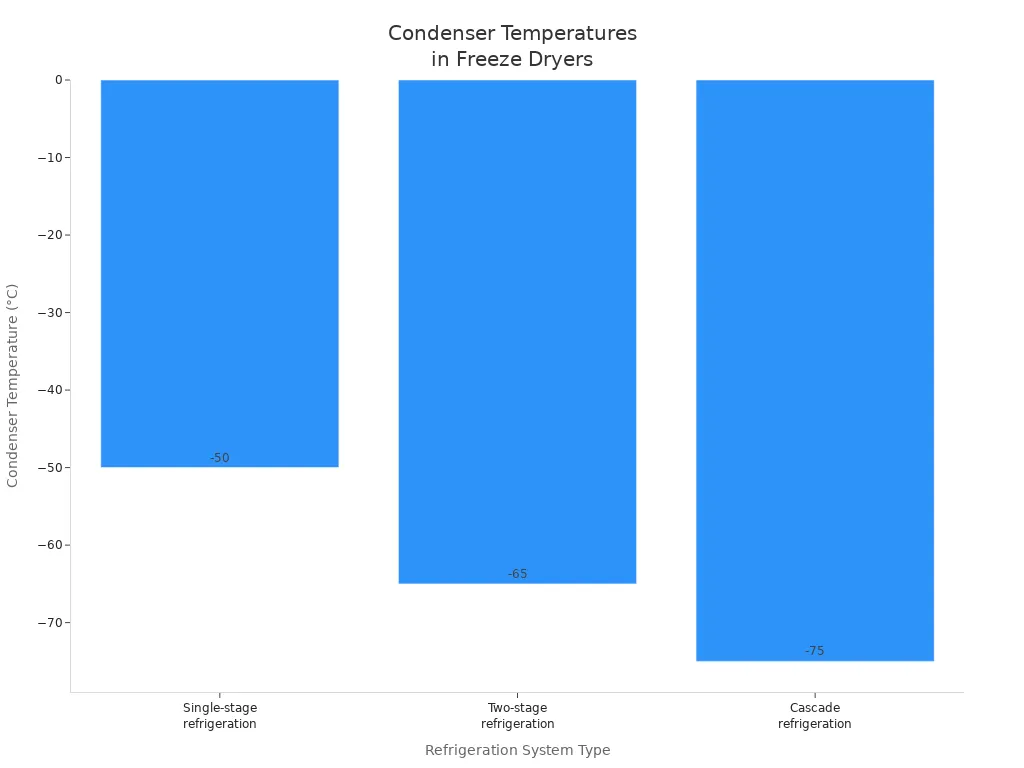
Control System
The control system is like the brain of your freeze dryer. It lets you set and check temperatures, pressures, and drying times. Modern control systems use sensors and smart programs to change settings as needed. You can set drying cycles for different foods. The system makes sure each step happens at the right time. Many freeze dryers have easy-to-use screens, alarms for problems, and reminders for care. Some advanced systems even use machine learning to save energy and make food better. Automation helps you get good results, makes fewer mistakes, and keeps your freeze dryer safe.
Tip: A good control system can save you time and protect your food by making sure every stage of freeze drying runs smoothly.
What Are the Uses of a Home Freeze-Dryer?
A home freeze-dryer is primarily used for preserving food by removing moisture, which extends shelf life and retains nutritional value. It is ideal for storing seasonal produce, creating lightweight emergency rations, and making nutritious snacks.
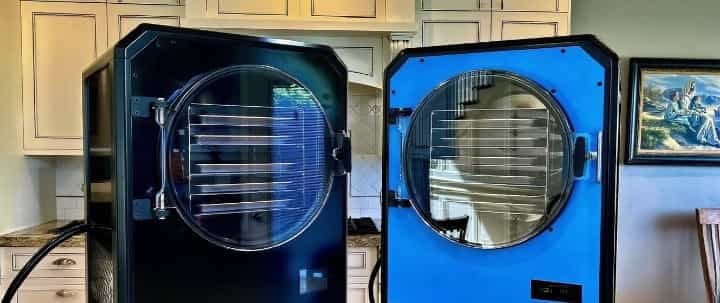
Freeze-Dried Foods
A home freeze-dryer helps you save many foods. You can freeze dry fruits, vegetables, meats, dairy, snacks, and even full meals. Here are some foods people often freeze dry at home:
Category | Commonly Freeze-Dried Foods |
|---|---|
Fruits | Citrus, cherries, grapes, watermelons, avocados |
Vegetables, Herbs, Spices | Broccoli, spinach, tomatoes, potatoes, peas, carrots, kale, mushrooms, onions, basil, mint, dill |
Meats, Eggs, Seafood | Beef, chicken, pork, eggs, cod, tuna, salmon, shrimp |
Dairy | Cheddar, gouda, yogurt, milk, ice cream |
Snacks & Desserts | Oatmeal bites, cheese bites, fruit chips, marshmallows, cakes, brownies |
Drinks | Coffee, fruit juices, smoothies, tea |
Full Meals | Casseroles, pasta, soups, cooked rice |
You can keep these foods for many years. Freeze drying keeps most of the taste, color, and nutrients. The food looks and tastes almost like fresh food. Experts say freeze drying saves more vitamins and antioxidants than other ways. For example, carrots keep almost all their carotenoids. Apples keep most of their vitamin C. You get healthy and tasty freeze-dried foods.
Note: Foods with a lot of fat or sugar, like butter or honey, do not freeze dry well at home.
Emergency Food Storage
A home freeze-dryer helps you make an emergency food supply. Freeze drying takes out almost all the water. This makes food last much longer than canned or dehydrated food. Here is a table that shows how long food lasts:
Food Preservation Method | Average Shelf Life |
|---|---|
Freeze-Dried Foods | Up to 25 years |
Dehydrated Foods | Up to 4 years |
Canned Foods | About 3 years |
You can store meals, fruits, and vegetables for a very long time. Freeze-dried foods are great for camping, hiking, or emergency kits. You just add water to make them ready to eat. They keep their taste and nutrition. A home freeze-dryer helps you get ready for anything with good food.
Other Applications
A home freeze-dryer can do more than food. You can use it for other things too. For example, you can freeze dry flowers to keep their color and shape. Some people freeze dry breastmilk or important papers. In science, freeze drying is used for medicines, vaccines, and samples. Here are more ways to use a freeze-dryer:
Non-Food Application | Description | Benefits |
|---|---|---|
Pharmaceuticals and Vaccines | Keeps medicines and vaccines safe and stable. | Longer shelf life, easy storage without a fridge. |
Flowers and Plants | Preserves flowers for decoration. | Keeps color and shape, lasts a long time. |
Biological Samples | Stores bacteria or tissue for research. | Keeps structure, easy to move without cold. |
Cosmetics | Makes beauty products last longer. | Stops spoilage, keeps ingredients fresh. |
Documents and Memorabilia | Protects paper and art from moisture. | Stops mold, keeps original look. |
With a home freeze-dryer, you can make many freeze-dried things. Freeze drying is a safe way to save food, flowers, and more for a long time.
What Are the Strengths and Weaknesses of Freeze-Dryer?
Freeze-drying, or lyophilization, excels in preserving perishable materials by removing moisture while maintaining structural integrity and nutritional content. However, it is an energy-intensive and time-consuming process with high equipment costs.
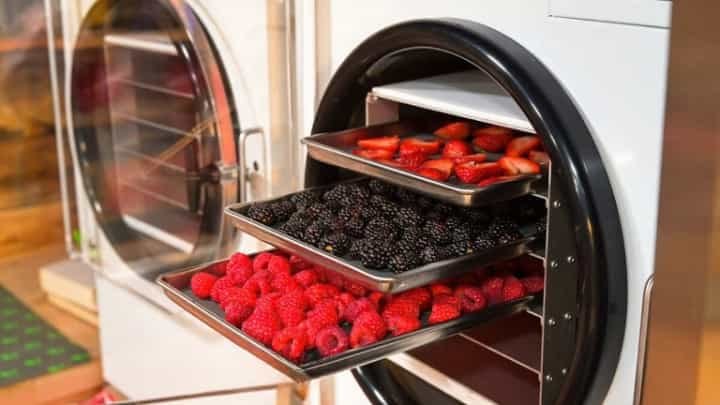
Benefits
When you use freeze drying at home or for your business, you get many advantages. You can keep food, medicine, and even flowers for a long time. Freeze drying helps you save the taste, color, and nutrients in your food. Here are some key benefits:
You can use more than one freeze dryer together, making it easy to grow your setup as you need.
Freeze drying gives you better control over how much you make. You can run small or large batches.
The process keeps food looking and tasting fresh. It also keeps most vitamins and minerals.
Freeze drying works well for many things, like snacks, pet food, and even medicine.
Home freeze dryers are easy to use. You do not need special training.
Smaller units are less risky. If one stops working, you can keep going with the others.
You get quick help if you have a problem. Many freeze dryers have self-check features.
You can start with one machine and add more as you grow.
Freeze drying lets you try new recipes and save food for emergencies. You can trust the product quality because the process uses low temperatures and no heat.
Drawbacks
Freeze drying is not perfect. You may face some challenges when you use a freeze dryer. Here are some common drawbacks:
Large pieces of food take longer to dry. Fatty meats can go bad if not dried right.
Mixing raw meat with other foods can spread germs. Freeze drying does not kill bacteria.
If you do not clean your freeze dryer after each use, it can clog or break.
Storing freeze-dried food the wrong way can make it spoil faster. Always use airtight containers.
Overloading trays makes the process slower and less effective.
Foods with lots of fat or sugar do not freeze dry well. Fat can spoil, and sugar stays sticky.
Not using tray liners makes cleaning harder and can mix flavors.
Drawback/Limitation | Explanation |
|---|---|
Freeze dryers cost a lot to buy and use more energy than other methods. | |
Time-Consuming Process | Freeze drying takes many hours, so it is not good for quick needs. |
Complex Operation | You must watch temperature, pressure, and moisture to get good results. |
Limited Capacity | Each freeze dryer can only handle a certain amount at once. |
Product Alteration | Changes in temperature or air can affect texture, flavor, or color. |
Vulnerability to Contamination | If you do not keep things clean, germs or dirt can get into your food. |
Shelf-Life Concerns | If you do not store freeze-dried food right, it will not last as long. |
Cost and Maintenance
Buying a freeze dryer is a big investment. Small home models cost about $1,995. Medium ones are around $2,900, and large ones can reach $2,995. Most people spend between $2,000 and $3,000 for a home freeze dryer. You also need to pay for electricity, which is about $2 to $5 for each batch. Vacuum pump oil costs very little because you can reuse it. Packaging, like mylar bags and oxygen absorbers, adds about $0.50 per meal.
You must clean your freeze dryer after every use. If you skip this step, you may have problems with clogs or bad smells. The machine needs regular checks to keep working well. Most home freeze dryers are made from stainless steel, so they last a long time and are easy to keep clean. You also get help from technical support if you need it.
Tip: While the first cost is high, the ongoing costs for freeze drying are low. You save money over time by making your own long-lasting food.
A freeze dryer lets you remove water from food using cold and vacuum. You keep food fresh, tasty, and full of nutrients for years. You save money and reduce waste. However, you must consider the high cost and time needed. If you want long-term food storage, emergency meals, or to preserve special items, a home freeze-dryer could help you.
Tip: Think about your needs and budget before you decide to buy a freeze dryer.
FAQ
How long does freeze-dried food last?
You can store freeze-dried food for up to 25 years if you use airtight packaging and keep it in a cool, dry place. This long shelf life makes freeze drying great for emergency food supplies.
Can you freeze dry cooked meals?
Yes, you can freeze dry cooked meals. You just need to cut them into small pieces and spread them evenly on the trays. After freeze drying, you can rehydrate your meals with hot water.
What foods should you not freeze dry?
Avoid foods with high fat or sugar, like butter, peanut butter, honey, and chocolate. These foods do not freeze dry well. They can stay sticky or spoil faster.
Is freeze drying safe for kids’ snacks?
Freeze drying is safe for kids’ snacks. You keep most nutrients and flavors. You also avoid added preservatives. Just make sure you store the snacks in airtight containers to keep them fresh.
How do you clean a home freeze dryer?
Unplug the machine.
Wipe the chamber and trays with a damp cloth.
Clean the vacuum pump as the manual says.
Dry all parts before using again.
Regular cleaning keeps your freeze dryer working well and your food safe.

